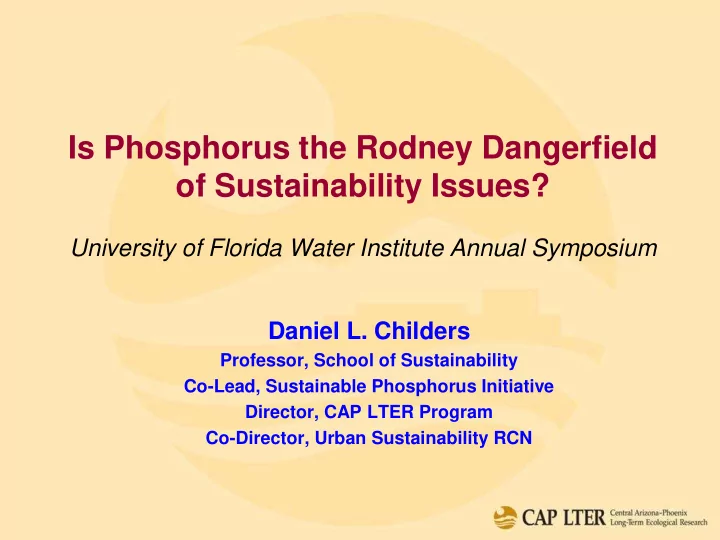

Is Phosphorus the Rodney Dangerfield of Sustainability Issues? University of Florida Water Institute Annual Symposium Daniel L. Childers Professor, School of Sustainability Co-Lead, Sustainable Phosphorus Initiative Director, CAP LTER Program Co-Director, Urban Sustainability RCN
Who is Rodney Dangerfield, anyway?
Outline and Overview 1. Primer on P as an essential element, the human P cycle, and associated sustainability challenges. 2. Two case studies of urban P cycling, storage, and fluxes from the Phoenix Metropolitan Area. 3. Addressing P sustainability challenges as a “wicked”, complex, and interconnected resource bailiwick.
1. Phosphorus is essential to all life Phosphorus comprises ~9% of the mass of nucleic acids, including DNA and RNA. Phosphorus is the biochemical and energetic center of ATP, ADP, etc. Figure from Sterner, R.W. and J.J. Elser 2002.
1. Phosphorus is essential to all life An average adult body contains roughly 1 kg of P, mainly in bones & teeth. Net input of P is only needed when an organism is growing (i.e. with no weight gain, organismal P flux is in steady state). The average adult consumes and excretes 1.2 g P every day.
1. Paradox: Phosphorus is both limiting and in over-abundance
1. P, Food, & the Human Population
1. P, Food, & the Human Population
1. The Human P “Cycle” Figure from Cordell et al. 2009.
1. The Human P “Cycle” Figure from Childers et al. 2011.
Outline and Overview 1. Primer on P as an essential element, the human P cycle, and associated sustainability challenges. 2. Two case studies of urban P cycling, storage, and fluxes from the Phoenix Metropolitan Area. 3. Addressing P sustainability challenges as a “wicked”, complex, and interconnected resource bailiwick.
2. Phosphorus in Urban Systems: The Phoenix P budget Central Arizona Phoenix Long-Term Ecological Research Program (CAP LTER) (http://caplter.asu.edu/) Figure from Metson et al. 2012. Ecol. Applications Photo: View from South Mountain by J.Corman
2. Phosphorus in Urban Systems: The Phoenix P budget Figure from Metson et al. 2012. Ecol. Applications
2. Phosphorus in Urban Systems: The Phoenix P budget 8 7 6 5 Gg of P/ year inputs 4 accumulation in landfills output 3 2 1 0 Figure based on Metson et al. 2012. Ecol. Applications
2. Phosphorus in Urban Systems: The Phoenix P budget Circle size = subsystem throughput (inputs + outputs) Figure from Metson et al. 2012. Ecol. Applications
2. Phosphorus in Urban Systems: The Phoenix P budget Dairy Agriculture Urban Core P Stocks: total accumulation in 2005 = 60.2 Gg P (=9.2 kg P ha -1 ) Figure from Metson et al. 2012. Ecol. Applications
2. Phosphorus in Urban Systems: Ag- urban interface dynamics (1978-2008) Cotton Alfalfa Dairy Figures from Metson et al. in review. J. Industrial Ecol.
2. Phosphorus in Urban Systems: Ag- urban interface dynamics (1978-2008) Maricopa County Land Harvest Cotton Seed Alfalfa Feed Cows Milk Chemical Fertilizer Uptake Crop residues Milk Manure Soils Irrigation Runoff Biosolids Urban Population Waste Water Figure from Metson et al. in review. J. Industrial Ecol.
2. Phosphorus in Urban Systems: Ag- urban interface dynamics (1978-2008) 2 P applied per acre Harvested P 20 1.8 1.6 15 kg of P 1.4 P (Gg) 1.2 10 1 cotton 0.8 5 0.6 alfalfa 0.4 0 total 0.2 0 year Year 500 Price of fertilizer (US) Price Index Value 400 500000 Agricultural Land 300 400000 acres 300000 200 total 200000 100 harvested 100000 0 P fertilizer 0 applied year year Figures from Metson et al. in review. J. Industrial Ecol.
2. Phosphorus in Urban Systems: Ag- urban interface dynamics (1978-2008) Maricopa County 1978 Maricopa County 2008 Land Land Imports Exports Imports Exports recycling recycling Serendipitous efficiencies achieved through: 1) close coupling of dairy and alfalfa production; 2) recycling of dairy manure back to alfalfa fields; 3) use of reclaimed water to irrigate alfalfa fields; 4) local consumption of local diary and associated meat; 5) lucky market pressures on cotton vs. alfalfa, and; 6) no surface water runoff means no aquatic P export. Figures based on Metson et al. in review. J. Industrial Ecol.
2. Phosphorus in Urban Systems: Ag- urban interface dynamics (1978-2008) Changes in P dynamics Outcome Mediating factors Changes in Changes in Changes in P + + Acreage Crops management Drivers Price of land Commodity prices Price of fertilizers Water availability Subsidies Environmental Urbanization Demand regulations Lending Capacity Figure based on Metson et al. in review. J. Industrial Ecol.
Outline and Overview 1. Primer on P as an essential element, the human P cycle, and associated sustainability challenges. 2. Two case studies of urban P cycling, storage, and fluxes from the Phoenix Metropolitan Area. 3. Addressing P sustainability challenges as a “wicked”, complex, and interconnected resource bailiwick.
3. Phosphorus Sustainability Challenges: The “wicked” problem P is a non-renewable resource on which we are completely dependent
3. Phosphorus Sustainability Challenges: Uneven P distribution
3. Phosphorus Sustainability Challenges: Price vulnerability is highly inequitable on a global basis Remember the spike in food prices and related riots in 2008?
3. Phosphorus Sustainability Challenges: The “wicked” complexities Phosphorus Food Sustainability
3. Phosphorus Sustainability Challenges: The “wicked” complexities Water Phosphorus Food Sustainability
3. Phosphorus Sustainability Challenges: The “wicked” complexities Energy Water Phosphorus Food Sustainability
3. Phosphorus Sustainability Challenges: The “wicked” complexities Energy Water Phosphorus Food Sustainability Supporting Ecosystems
3. Phosphorus Sustainability Challenges: The “wicked” complexities Energy Water Phosphorus Food Sustainability Market Supporting Prices Ecosystems
3. Phosphorus Sustainability Challenges: The “wicked” complexities Energy Water Phosphorus Food Sustainability Market Supporting Prices Ecosystems Regional & Global Inequity, instability, national security issues, war
3. Phosphorus Sustainability Challenges: The “wicked” complexities Human Population Change Energy Water Phosphorus Food Sustainability Market Supporting Prices Ecosystems Regional & Global Inequity, instability, national security issues, war
3. Phosphorus Sustainability Challenges: The “wicked” complexities Human Population Change + Climate Change Energy Water Phosphorus Food Sustainability Market Supporting Prices Ecosystems Regional & Global Inequity, instability, national security issues, war
Ways to Learn More & Get Involved http://sustaina blep. asu.edu http:// Globalp Network. net
Recommend
More recommend